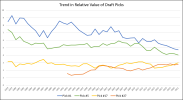Wow So it's conceivable Jazz could make four great picks and then what would they doTwo first-rounders and two second-rounders. Jazz could be looking at prospects in the 2nd round, or they might be looking to attach those picks to players in trades. I'd be a bit surprised if the Jazz drafted with all four picks, though Zanick says he likes "more swings."
You are using an out of date browser. It may not display this or other websites correctly.
You should upgrade or use an alternative browser.
You should upgrade or use an alternative browser.
Following Potential 2025 Draftees
- Thread starter Elizah Huge
- Start date
Wow So it's conceivable Jazz could make four great picks and then what would they do




I doubt we use 4 roster spots on rookies next year. I think we look to sell, draft and stash, or draft and sign to a two way with our second round picks. With where we are at as a team, the draft and stash route seems the best.
Tremendous Upside
Well-Known Member
it's not just georgia tech. he can score against anybody. he averages 14 ppg on 63% TS. as a frosh. you should understand that kind of production and efficiency is extremely rare at the P4 level.
The problem with Knueppel is that he needs to use every old-man trick in the book to get enough separation at the college level. Hesitations, headfakes, stutter steps, bumping people out of balance... just a ton of work. And this on a team where defenses don't even have time to worry about him that much.
He has a chance to carve out an NBA career as a situational spot up shooter off the bench, but to expect anything more than that is just preposterous. I mean the guy is like 6'5'' and slow.
Fleming having a nightmare tournament
This is Sergio de Larrea, 19, from Spain. He's playing for Valencia in the Spanish ACB, and has been playing lower-level professional ball since he was 15. He's the same size as Kasparas Jakucionis at 6'6" / ~200 lbs, shooting 51/45/76, playing both on and off the ball. He's a good passer and seems to hold up defensively for the most part. The main question mark is his limited minutes at just over 12 mpg. However, if you believe in extrapolating numbers on a Per 36-min basis, he's impressive -- 16/7/8 + 1.4 stl.
He should be available later in the 1st round and could work as a stash candidate or someone to bring over right away. I think he's currently underrated.
View: https://www.youtube.com/watch?v=q5IaSsDaPio
He should be available later in the 1st round and could work as a stash candidate or someone to bring over right away. I think he's currently underrated.
View: https://www.youtube.com/watch?v=q5IaSsDaPio
Last edited:
HadAnEffectHere
Well-Known Member
View: https://bsky.app/profile/cjzero.bsky.social/post/3lkh2z3l22c22
If Derik Queen was just a litttttle longer.
His skill level is really reminiscent of young Embiid/Jokic.
View: https://bsky.app/profile/cjzero.bsky.social/post/3lkh2z3l22c22
If Derik Queen was just a litttttle longer.
His skill level is really reminiscent of young Embiid/Jokic.
That Danny Wolf defense
Well at least Fleming is ending his season on a bad note so he has a chance to be available with the Wolves pick.
View: https://bsky.app/profile/cjzero.bsky.social/post/3lkh2z3l22c22
If Derik Queen was just a litttttle longer.
His skill level is really reminiscent of young Embiid/Jokic.
He's going to be a load from 17 feet or so in, if he can get space to operate. Kind of like Zach Randolph, except he's a good passer.
IIRC Randolph was a solid passer, especially in Memphis.He's going to be a load from 17 feet or so in, if he can get space to operate. Kind of like Zach Randolph, except he's a good passer.
seattlejazzfan
Well-Known Member
he's been so consistent over the last month/month and a half.Jace reminds me of Donovan if Donovan couldn't fly. I'm not sure how valuable that player is, but it's probably worth a lottery pick.
seattlejazzfan
Well-Known Member
nique clifford may be being slept on. there is a lot of josh hart there. old af, but an elite rebounder for his size/position, very good passer/playmaker, big strong body, defends and can shoot.
I'm pretty sure Nique Clifford can come in to the league and have a Tristan Da Silva kind of impact. He's good at everything and enough size and athleticism to fit in the league.
kcgar
Well-Known Member
i've never seen him play (only highlights). the highlights from last night are encouraging - it looks like he can legit play some three on offense. they often give him the ball on the perimeter and let him create from out there. shows ball handling chops and a natural feel as a passer (an impressive play at about the 2:47 mark where throws a guy open on a skip pass) and he has a really good looking shooting stroke. they play a very good north texas team at 3pm utah time today on espn2.
View: https://www.youtube.com/watch?v=vBOaQjNejYQ
His arms look so long. He looked great!
This is from a year ago, when Essengue had recently turned 17. A 9'3" standing reach is greater than Alex Sarr or Yves Missi from last year's Combine. It's fair to predict that he's going to turn some heads during the pre-draft process.
View: https://x.com/DraftExpress/status/1759250618554696098
View: https://x.com/DraftExpress/status/1759250618554696098
View: https://bsky.app/profile/cjzero.bsky.social/post/3lkh2z3l22c22
If Derik Queen was just a litttttle longer.
His skill level is really reminiscent of young Embiid/Jokic.
More in the mold of Demarcus Cousins.
HadAnEffectHere
Well-Known Member
More in the mold of Demarcus Cousins.
Nah, Cousins was a proto version of Embiid, but had really inconsistent body control and was a terrible shooter who was obsessed with taking jumpshots.
This doesn't deserve it's own thread, but doesn't really fit with any of the threads, so maybe it's as good a place as any to put it:
I've mentioned in another thread that there seems to be movement toward convergence in the value of draft picks, especially compared to a generation ago. In other words, it's getting harder to predict where the top players are going to come from in the draft. (This is not to say that drafting later has the same odds for getting a strong player as drafting earlier; the odds are still best to draft early, of course. It's just that the difference between the kind of players you get drafting later compared to drafting earlier is narrowing, especially in recent years). The following graphs, which are based on small research projects I've done, provide evidence for this idea, I think.
The first shows what draft picks the 1st, 2nd, and 3rd All-NBA teams come from, on average. You'll see that there's a great narrowing in the last 10 years especially, with 1st-teamers coming from later and later in the draft. This year's 1st team could easily be as high as a 16.6 average.
The second chart shows the relative value of four first round picks, selected to best illustrate the trend (based on a blend of career win shares and VORP scores). Top picks have generally lost value over time, mid-round picks have kept their value somewhat, lower-round picks have increased their value. (In both graphs, lots of data smoothing has been employed to help highlight what seem to be real trends.)


I've mentioned in another thread that there seems to be movement toward convergence in the value of draft picks, especially compared to a generation ago. In other words, it's getting harder to predict where the top players are going to come from in the draft. (This is not to say that drafting later has the same odds for getting a strong player as drafting earlier; the odds are still best to draft early, of course. It's just that the difference between the kind of players you get drafting later compared to drafting earlier is narrowing, especially in recent years). The following graphs, which are based on small research projects I've done, provide evidence for this idea, I think.
The first shows what draft picks the 1st, 2nd, and 3rd All-NBA teams come from, on average. You'll see that there's a great narrowing in the last 10 years especially, with 1st-teamers coming from later and later in the draft. This year's 1st team could easily be as high as a 16.6 average.
The second chart shows the relative value of four first round picks, selected to best illustrate the trend (based on a blend of career win shares and VORP scores). Top picks have generally lost value over time, mid-round picks have kept their value somewhat, lower-round picks have increased their value. (In both graphs, lots of data smoothing has been employed to help highlight what seem to be real trends.)


View: https://www.youtube.com/watch?v=7W-eAtOR5dY&ab_channel=NoCeilingsNBA
He just finds space so well
View: https://www.youtube.com/watch?v=7W-eAtOR5dY&ab_channel=NoCeilingsNBA
He just finds space so well
I'm trending towards Jace as a top 10 pick, but the end of the Wisconsin game yesterday really highlighted some of his concerns. MSU was down a couple points and desperately needed a basket and Jace couldn't seperate in order to get a shot off. At times he couldn't even separate enough to get the ball.
